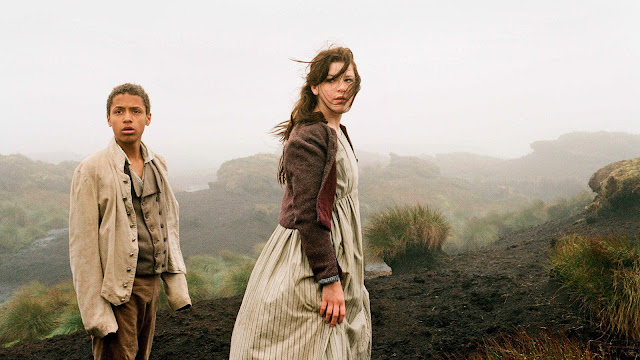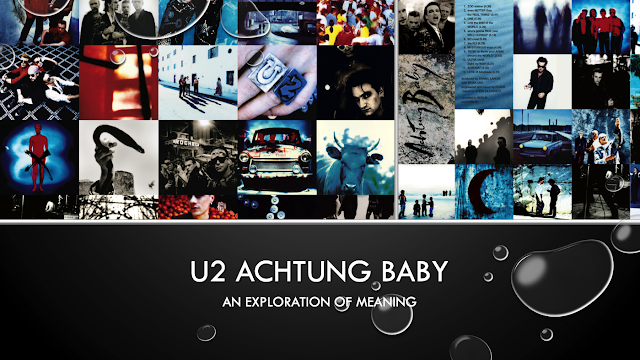ENGL 538 Reading Journal #1: Wuthering Heights
 |
| Young Heathcliff and Catherine. Scene from the 2011 film adaptation of Wuthering Heights directed by Andrea Arnold |
 |
| Young Heathcliff. Scene from the 2011 film adaptation of Wuthering Heights directed by Andrea Arnold |
Reading Journal #1: Response to Wuthering Heights
I thought Wuthering Heights was a fantastic novel. As the story unfolded it drew me in right away. The odd collection of characters and the comical way in which they were introduced both to Lockwood and the reader fired my interest. In this journal, I’ll share my thoughts on some of the characters and my interpretation of Heathcliff’s motivations before I address Armstrong’s and Meyer’s critical perspectives. Let’s begin with Mr. Lockwood. He is a wealthy gentleman that rents a house in the country, Thrushcross Grange, in order to escape the London social scene and to hunt. His initial encounter with his landlord, Heathcliff, is a series of comedic errors. Lockwood’s expectations of behavior and social norms, based on his genteel life in London, fall flat at Heathcliff’s home, Wuthering Heights, where the servants are surly and marginally obedient, and Heathcliff is unfriendly and dour. He commits a series of social errors before he finally returns to Thrushcross Range the following morning. His experiences give us a glimpse at the partial cast of characters and his encounter with the nightmare version of Catherine (the elder) puts the reader on notice that there is more afoot than a strained tenant-landlord relationship. Lockwood’s subsequent illness keeps him sequestered at home and allows for the introduction of Ellen “Nelly” Dean and creates the circumstance for Nelly to describe and recount the events of the previous decades. Nelly recounts the history of the Earnshaws and Lintons and the destructive machinations visited on both families by Heathcliff. Throughout Nelly’s narrative, she paints herself as an innocent bystander that is just doing her part as a servant (although she also has a pseudo-sibling relationship with the Earnshaw children). She does occasionally acknowledge where she may have deviated from her instructions or where she chooses to disregard information or to keep it to herself. She does not, however, really acknowledge that she had a clear understanding of Heathcliff’s intentions because, like a super villain in a B-movie, he monologues his heinous intentions to her whenever they meet, but she complies in every case. Nelly was the only person in the entire narrative that typically had most, if not all, the information yet failed to act on it in any way to intervene and avoid catastrophe. She is complicit with Heathcliff. Joseph, the old servant and chronic quoter of Biblical verse at Wuthering Heights, is equally complicit with Heathcliff. This character struck me as a caricature of the extremely pious. While Joseph does a lot of Bible reading and quoting, he does not act in accordance with his preaching and instead is complicit in Heathcliff’s corruption of Hareton Earnshaw. There is a brief moment when we get the sense that Joseph is rooting for Hareton to regain control of Wuthering Heights as its rightful heir, but this moment is brief. The only moment of real humanity we get from Joseph is when Hareton and Catherine (the younger) pull up his garden and his favorite black currant trees (Brontë 272). Joseph comes across as very distressed and wounded. After this scene, I got the impression that Joseph was just doing what he could to survive a mean life with a harsh master, but without real choices or means of escape/change, and so he gleans his few joys from his garden. The two Catherines are fascinating. Catherine the elder is difficult and can be vicious. She identifies with Heathcliff because they share a certain ruthlessness and manipulative capacity. Catherine the younger has some of the elder’s traits, but in a very small dose by comparison. Where my impression of the elder Catherine is one of selfish indulgence, the younger Catherine is a warmer and gentler spirit. What’s interesting about both the elder and younger Catherine, is the amount of power they wield. Although the circumstances each of them faces differ very much, each Catherine wields enough power and influence to get what they want. Heathcliff is my favorite character in the novel. He is the orphan that Mr. Earnshaw brings home and adopts into his family and while he is there, he’s not embraced by all. He’s different enough to be considered an outsider in both appearance and demeanor. Hindley Earnshaw abuses him at every turn and the servants remind him frequently that he is different. Heathcliff leaves Wuthering Heights after he overhears Catherine say she couldn’t marry him, and I think he makes up his mind at that point to come back and to repay the unkindness he’s experienced. That’s what we see three years later when he deliberately and almost mechanically disassembles both the Earnshaw and the Linton families. He finds their vulnerabilities and usurps their property rights until both families are shadows of themselves and Heathcliff owns everything and controls everything, including the Earnshaw and Linton children. His treatment of his own child, Linton Heathcliff, as a pawn and commodity illustrates the dedication Heathcliff has to his agenda and the cold, callous way in which he proceeds to execute his plan. My favorite of his diabolical machinations (it’s so wicked; who thinks of this stuff?) is the way he eliminates Hindley by feeding his vices and then inherits Hareton to raise. In raising him he channels his own abusive experiences and the brutal way Hindley treated him as a child and turns Hareton into an uncouth brute by denying him any real training or education and turns him into a servant in his own ancestral home, the same way Hindley treated Heathcliff once Hindley was in charge of Wuthering Heights. It’s kind of poetic (and very cruel). Of course, it all works out in the end and we get the impression that Catherine and Hareton get to live happily ever after. Nancy Armstrong’s critical perspective on Wuthering Heights and its effective miniaturization of an entire group of people and their subsequent reduction of archetypes similar to a display we might see in a museum was thought provoking for me. I appreciated Armstrong’s approach to her critique and the way she built up her scaffolding around Charlotte Brontë’s motivations for her 1850 preface to Wuthering Heights and also the context of how folklore emerged and changed perceptions in her milieu. To consider that what we call folklore, coined by William Thorns, was an emerging thing; one that grew out of the increasing popularity of cataloguing and recording “superstitions, cures, and arcane practices,” places Wuthering Heights and Charlotte Bronte’s aforementioned preface in an interesting light. It reveals a possible motive for Charlotte’s characterization of Emily and gives it a commercial twist. I found Armstrong’s discussion of the violent acts and themes in Wuthering Heights interesting and hadn’t quite connected all the dots she mentions in my initial reading of the text. There is a steady stream of violence in the novel, but Armstrong’s connection of these to the cultural phenomenon of cataloguing, minimizing, and stereotyping rural England and the reduction of people and regions to what amount to artificial copies a powerful condemnation of the cultural erasure taking place at the time. Susan Meyer’s critical analysis of reverse imperialism and the various incarnations of Heathcliff as a representative of the “dark races” and all the peoples subjugated by the British Empire struck me as a thorough and powerful analysis of Wuthering Heights. I detected some of the threads she mentioned—particularly the vengeful reversal of circumstances Heathcliff visits upon Hareton—but I did not catch so many of the nuanced and historically contextual complexities embedded in the novel as Meyer reads it. The idea that Heathcliff returns after three years of absence to England after fighting on the American side in the Revolutionary War and is drawing blood from his foster country is a powerful articulation of rebellion. And yet, it is quietly embedded in the novel with just a few references to where Heathcliff was during his absence. A reader at the time of publication might have caught on immediately, but for modern readers this may as well be written in code. The frequent references to sharp teeth and cannibalism, on the other hand, are more accessible to the modern reader. However, Meyer puts it in a colonial context and depicts Heathcliff as the reverse colonizer that not only returns to destroy and dismantle his oppressors, but to consume them (Meyer 498-99). Thus, Heathcliff has the power to violates the most intimate of boundaries—the body. The power and depth of Heathcliff’s character and the powerful social critique Brontë embedded in him strike me as masterful. After reading Meyer’s analysis, I’m inclined to read Wuthering Heights again to appreciate all the subtleties of Heathcliff’s character more.
Works Cited
Armstrong, Nancy. “Imperialist Nostalgia and Wuthering Heights.” Wuthering Heights: Case Studies in Contemporary Criticism. 2nd edition. Edited by Linda Peterson, Bedford/St. Martin’s Press, 2003. Brontë, Emily. Wuthering Heights: Case Studies in Contemporary Criticism. 2nd edition. Edited by Linda Peterson, Bedford/St. Martin’s Press, 2003. Meyer, Susan. “Your Father Was Emperor of China, and Your Mother an Indian Queen”: Reverse Imperialism in Wuthering Heights.” Wuthering Heights: Case Studies in Contemporary Criticism. 2nd edition. Edited by Linda Peterson, Bedford/St. Martin’s Press, 2003. |

